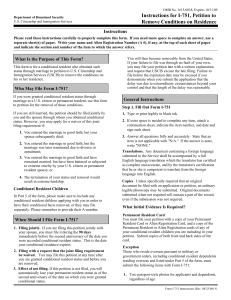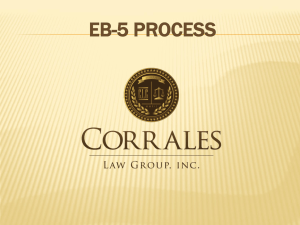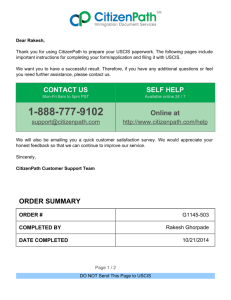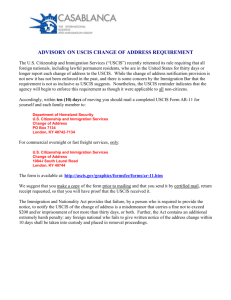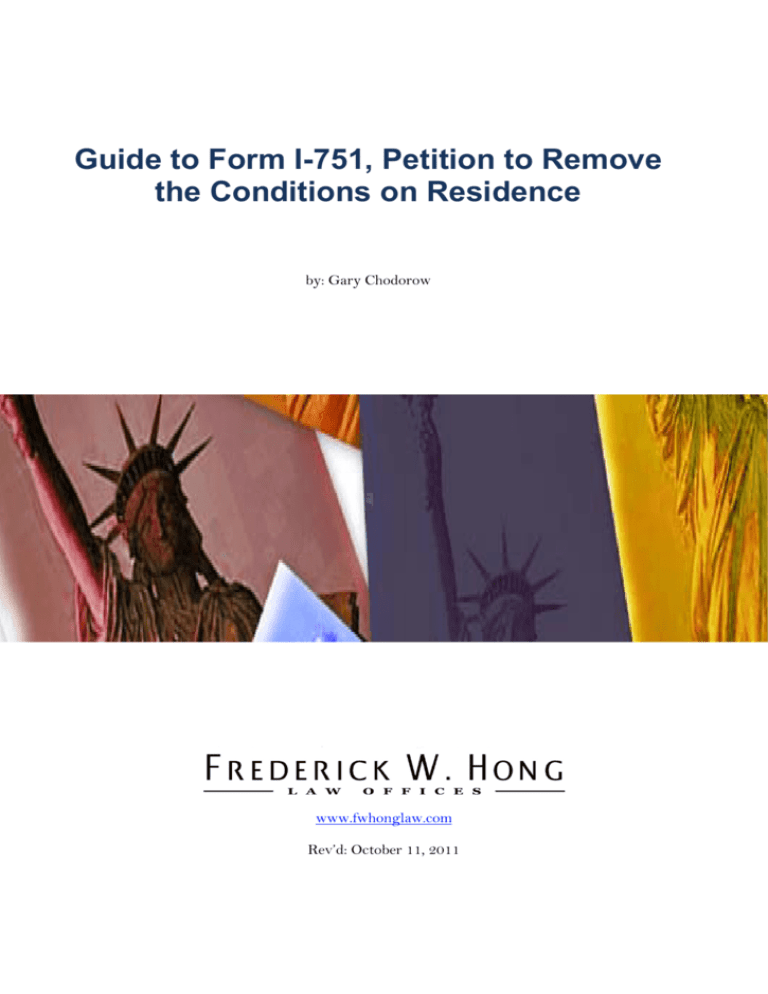
Guide to Form I-751, Petition to Remove
the Conditions on Residence
by: Gary Chodorow
www.fwhonglaw.com
Rev’d: October 11, 2011
Frederick W. Hong Law Offices
Frederick W. Hong Law Offices has a proven track record advising companies and individuals
on China and U.S. business law, intellectual property, and immigration law.
The firm was founded in 1977 in Los Angeles. After developing business in China in the 1980s,
we became in 1993 the first U.S. law firm licensed by China's Ministry of Justice to open an
office in Guangzhou. In 2002, the firm was authorized to open another office in Beijing.
We make an effort to understand each client's business and goals. Our attorneys are savvy,
innovative, and focused on getting results that meet our clients' needs. That's how we establish
lasting client relationships.
Gary Chodorow
The author, Gary Chodorow, is chief representative for the Beijing office of Frederick W. Hong
Law Offices. His practice has focused on U.S. immigration and nationality law since 1993. He is a
frequent author and speaker on related issues, and a member of the American Immigration
Lawyers Association.
Beijing Office
Tel.: +86.10.6506.1180
Email: gary@fwhonglaw.com
Web: www.fwhonglaw.com
Blog: www.LawAndBorder.com
Table of Contents
1. Introduction .................................................................................................................................................. 1
2. Requirements for Removal of the Conditions on Residency ............................................................. 1
3. Procedures for the I-751 ............................................................................................................................ 2
Filing............................................................................................................................................................... 2
Considerations for Persons Living Abroad Temporarily ................................................................... 2
Evidence of a Valid Marriage .................................................................................................................... 3
Dependent Children .................................................................................................................................... 3
Receipt Notice and Tracking Case Status .............................................................................................. 4
Biometrics ...................................................................................................................................................... 4
Interview ........................................................................................................................................................ 4
Travel Abroad while the I-751 Is Pending ............................................................................................ 5
Change of Address while the I-751 is Pending ..................................................................................... 5
Eligibility for Naturalization Before Approval of the I-751 .............................................................. 5
Decision .......................................................................................................................................................... 5
Issuance of the New Permanent Resident Card.................................................................................... 6
4. Conclusion ..................................................................................................................................................... 7
Copyright © 2010-2011 Frederick W. Hong Law Offices. All rights reserved.
1. Introduction
A spouse who immigrates based on marriage to a U.S. citizen or lawful permanent resident will be
granted conditional resident (CR) status if, at the time of admission as an immigrant, the marriage
is less than two years old.
A child may also become a conditional resident if they immigrate on the basis of an immigrant
petition by a U.S. citizen stepparent. If the child immigrates to the U.S. while the marriage is less
than two years old, USCIS will grant the child conditional resident status.
If you are a conditional resident, you should file a Form I-751, Petition to Remove Conditions on
Residence, during the 90-day period before your two-year “anniversary” of being granted
conditional resident status. 1 In other words, file during the 90-day window before your Form I-551,
Permanent Resident Card, expires.
This is a guide to the I-751 process. Part 2 describes the requirements. And Part 3 describes the
procedures.
2. Requirements for Removal of
the Conditions on Residency
A conditional resident’s status is, in effect, probationary. Conditional residents, while having the
same rights and responsibilities of a permanent resident, obtain residency for only two years and
must file an I-751 at the end of that two-year period in order to retain residency. Specifically, the I751 must be filed during the 90-day window immediately before the second anniversary of the date
you were granted conditional resident status.
The purpose of the I-751 is to reconfirm that the marriage was valid at its inception. The I-751 is
accompanied by evidence of the validity of the marriage. If upon reviewing the I-751 USCIS agrees
that the marriage was valid, USCIS may then remove the conditions so that the conditional
resident becomes a full permanent resident. 2 Conversely, if: (a) the marriage has ended in
annulment or divorce, (b) USCIS believes that the marriage was fraudulent from its inception, or (c)
the conditional resident fails to comply with the proper procedures to file the I-751, then USCIS
may terminate the conditional resident’s legal status.
Note that if the conditional resident’s relationship with the petitioning spouse has failed during the
two-year conditional period, the conditional resident may nonetheless petition USCIS to grant full
permanent residency if: (a) the petitioning spouse has died; (b) the marriage was entered into in
good faith but has ended in divorce or annulment; (c) extreme hardship would otherwise result due
to factors which arose subsequent to the conditional resident’s immigration; or (d) the couple
18
C.F.R. § 216.4(a)(1).
More specifically, USCIS shall determine whether:
a. The marriage was entered into in accordance with the laws of the place where the marriage took place.
b. The qualifying marriage has been annulled or terminated (other than through death of the spouse).
c. The marriage was entered into for the purpose of procuring permanent resident status for the alien.
d. A fee or other consideration was provided (other than to an attorney) in connection with the petition
through which the alien obtained conditional permanent residency.
INA § 216(d)(1); 8 C.F.R. § 216.4(c).
2
1
married in good faith but the petitioning spouse physically abused the conditional resident or a
child or subjected them to extreme mental cruelty. Detailed discussion of these exceptions to the
joint petition process is beyond the scope of this Guide.
3. Procedures for the I-751
Filing
The I-751 is filed by mail with the USCIS Service Center with jurisdiction over the conditional
permanent resident’s place of residence. 3
A jointly filed I-751 must be filed within the mandated time period, signed by the CR and spouse,
and accompanied by supporting documentation confirming the validity of the marriage. 4
Upon proper filing, CR status is extended automatically until such time as USCIS adjudicates the I751. 5
If the joint petition is not filed timely, the CR will accrue unlawful presence in the U.S. until such
time as the petition is filed and USCIS accepts the filing. 6 Such unlawful presence may make the
former CR inadmissible if he or she departs the U.S. prior to the filing and acceptance by USCIS. 7
Considerations for Persons Living Abroad Temporarily
Even if you are living abroad temporarily, you must still file the I-751 with the Service Center
having jurisdiction over your last place of residence in the U.S.
There is no requirement that you be physically present in the U.S. at the time the I-751 is filed. 8
The regulations are silent about which USCIS office has jurisdiction. But see I-751 Instructions at 3 (rev.
Dec. 30, 2009) (I-751 should be filed with the Vermont or California Service Center, depending on where the
conditional resident “live[s].”); AFM 25.1(c)(1) (file with Service Center with jurisdiction over the “alien’s
place of residence.”)
48 C.F.R. § 216.4(a)(1).
58 C.F.R. § 216.4(a)(1).
6 INS Memorandum, P. Virtue, “Section 212(a)(9)(b) Relating to Unlawful Presence” (Sept. 19, 1997),
published on AILA InfoNet at Doc. No. 97092240 (posted Sept. 19, 1997).
7Id.
8 USCIS, Removing Conditions on Permanent Residence Based on Marriage, http://snipurl.com/1t5tuast, last
visited Nov. 5, 2007; 8 CFR §216.4(a)(4) Physical presence at time of filing: “A petition may be filed
regardless of whether the alien is physically present in the United States. However, if the alien is outside the
United States at the time of filing, he or she must return to the United States, with his or her spouse and
dependent children, to comply with the interview requirements contained in the Act. Furthermore, if the
documentation submitted in support of the petition includes affidavits of third parties having knowledge of
the bona fides of the marital relationship, the petitioner must arrange for the affiants to be present at the
interview, at no expense to the government. Once the petition has been properly filed, the alien may travel
outside the United States and return if in possession of documentation as set forth in § 211.1(b)(1) of this
chapter, provided the alien and the petitioning spouse comply with the interview requirements described in §
216.4(b). An alien who is not physically present in the United States during the filing period but
subsequently applies for admission to the United States shall be processed in accordance with § 235.11 of
this chapter [re: admission of CRs].”
3
2
But if your I-751 lists a foreign address, your case will be held by USCIS until you report that you
have notified USCIS that you have moved back to the U.S. and a U.S. address is put into the system,
at which point it will be moved into the processing queue. 9 The USCIS rationale for the “overseas
hold” is that it may not be feasible for a CR living abroad to attend the required biometrics
appointment and interview. 10
To avoid the overseas hold, an applicant should be sure to list a U.S. address. It may be also be
important for the I-751 to explain the reason the CR is overseas, demonstrate that CR status has
not been abandoned, 11 state that the CR will attend the scheduled biometrics interview and
appointment, and request that the case not be subject to the overseas hold.
Evidence of a Valid Marriage
The joint petition should be accompanied by supporting evidence that the marriage was not
entered into for the purpose of evading the immigration laws of the United States. Documents
which may be submitted include but are not limited to: (1) joint ownership of property, (2) joint
tenancy of a common residence, (3) commingling of financial resources, (4) birth certificates for
children born of the marriage, and (5) affidavits of persons having knowledge of the bona fide
marital relationship.
Dependent Children
Dependent children who became permanent residents within 90 days of the parent may be included
in the joint petition. However, all dependents included in the petition must pay a separate
biometrics fee. Dependent children who cannot be included in the joint petition because they did
not immigrate within 90 days of the parent or because of the death of the parent may file a separate
petition. 12
Receipt Notice and Tracking Case Status
In recognition of the lengthy delays in obtaining a decision on an Form I-751, Petition to Remove
the Conditions on Residence, USCIS issues a filing receipt that extends a conditional resident’s
9 AFM 25.1(g)(4)(C). For military cases, there is an exception to the “overseas hold.” You must have a valid
APO or FPO address. See also AILA-SCOPS Q & A September 17, 2008; Report of ISD Teleconference,
AILA InfoNet Doc. No. 00101702 (posted Oct. 17, 2000) (“ In response to our question regarding I-751
cases where a foreign address is provided by the petitioner and beneficiary and the petition is automatically
placed on an overseas hold, INS has stated that if a U.S. address is listed on the form (c/o another party),
INS will be able to adjudicate the I-751. Therefore, members are advised to file all I-751 petitions that they
don’t want placed on an overseas hold with a U.S. address.”).
10 USCIS American Immigration Lawyers Association (AILA) Meeting, March 19, 2009 at p.6-7. (“Petitions
that indicate that the CR is temporarily overseas, but not on government/military orders, are reviewed for
information concerning the reason they are overseas and when they intend to return to the U.S. I-751
petitions require ten-print fingerprints as well as biometrics and identity verification. Once the biometric
requirement is met, an officer will review the application for eligibility. If the CR is deemed eligible for
removal of conditions, an I-551 card will be issued; all I-551 cards must be mailed to a U.S. address provided
by the CR. If the CR does not comply with the biometric requirement, the petition will be denied in
accordance with 8 CFR §103.2(b)(13)(ii)).
11 A reentry permit may be helpful in this regard.
128 C.F.R. § 216.4(a)(2), (4); Form I-751 Instructions (Rev. Dec. 30, 2009).
3
status for a full year beyond the date shown on the I-551. The receipt (accompanied by the I-551
and an unexpired foreign passport) is valid for entry to the U.S. following travel abroad. Also, the
receipt (accompanied by the I-551 and an identity document such as a state driver’s license, ID card,
or passport) is evidence of employment authorization in the United States which can be provided to
an employer for purposes of proving eligibility to work. If USCIS does not adjudicate the I-751
within that year, USCIS is supposed to expedite adjudication of the case.
The status of an I-751 can be tracked online at www.uscis.gov. You also have an option to sign up
for email or SMS status updates. Please note that for I-751s, USCIS tracks cases by the “application
number” shown on the biometrics appointment notice, not by the “receipt number” shown on the
receipt notice (which if tracked just shows “your case cannot be found”). Also please note that the I751 will be shown in the system as a “CRI89 Petition to Remove Conditions of Permanent
Residence.”
Biometrics
You will receive an appointment notice to visit a USCIS Application Support Center after you have
filed Form I-751 to have your biometrics (photo, signature, fingerprints) electronically captured. 13
The photograph, signature and index finger print will later be used to generate the new I-551
when the Form I-751 is approved.
The ten fingerprints are taken for the purpose of conducting a criminal background check for
applicants between the ages of 14 to 79.
Interview
The USCIS regional center where the I-751 is filed may in its discretion waive the interview.
USCIS will do so if satisfied based on the evidence filed with your I-751 that your marriage was
entered into in good faith. 14 (This is especially true for spouses of active U.S. military personnel
stationed overseas). This is an important reason to file a complete and well-prepared I-751 package.
Otherwise, your I-751 will be forwarded to a local USCIS office and you will receive a notice
requiring appearance at a local USCIS office for an interview. (It’s technically possible for the local
office to decide to waive the interview too. 15) Failure to attend the interview may result in
termination of the conditional resident’s status and the commencement of removal (i.e., deportation)
proceedings.
Travel Abroad while the I-751 Is Pending
To be admitted to the U.S. during the period after the I-551 has expired and before the I-751 is
adjudicated, you should carry your passport, expired I-551, and the I-751 receipt issued by USCIS.
USCIS, Update: New Biometrics Process for Conditional Permanent Residents, Feb. 28, 2007, AILA Infonet
Doc. No. 07030261.
148 C.F.R. § 216.4(b)(1) (2007); USCIS, Removing Conditions on Permanent Residence Based on Marriage,
http://snipurl.com/1t5tuast, last visited Nov. 5, 2007.
158 C.F.R. § 216.4(b)(1).
13
4
If you are living abroad temporarily, you should consider the utility of applying for a reentry
permit to avoid a determination by the U.S. Customs and Border Protection inspecting officer at
the port of entry that you are inadmissible on the basis of having abandoned your CR status.
What If the I-751 Is Still Pending More Than One Year After Your I-551 Has Expired?
As mentioned above, in recognition of the lengthy delays in obtaining a decision on a Form I-751,
USCIS issues a Form I-797 filing receipt that extends a conditional resident’s status for a full year
beyond the date shown on the I-551. If the I-751 is still pending after that year has passed, then the
applicant should obtain additional evidence of CR status.
Take the I-797 receipt, the I—551 card, and an unexpired passport to the local USCIS district
office to request a new stamp in the passport to indicate extension of conditional resident status for
an additional year. 16 An appointment may be required.
Change of Address while the I-751 is Pending
If you move prior to receiving the I-551, please tell our firm so we can notify USCIS of your new
address. (USCIS does not allow the Post Office to forward the I-551 from your old address to a new
address).
Eligibility for Naturalization Before Approval of the I-751
You may file a Form N-400, Application for Naturalization, notwithstanding the fact that your I751 filing period has not started and notwithstanding the fact that your I-751 has not yet been filed
or is pending. 17 If you have already filed your I-751, notify the USCIS office handling your
naturalization case so that the I-751 can be adjudicated at the same time as the naturalization
application. 18
A key requirement for naturalization is the continuous residence requirement. For most
naturalization applicants, the requirement is that you have resided in the U.S. continuously for 4
years and 9 months after gaining CR or LPR status. However, that requirement is reduced to 2
years and 9 months if during that period you have lived in the U.S. with your citizen spouse. There
is also a special provision allowing expedited naturalization with no continuous residence
requirement for spouses of U.S. citizens employed abroad by U.S. companies or their subsidiaries.
Decision
William R. Yates, Acting Assoc. Director for Operations, BCIS, Extension of Status for Conditional Residents with
Pending Forms I-751, Petition to Remove Conditions on Residence, Dec. 2, 2003, AILA Infonet Doc. No. 03120940;
Questions and Answers: USCIS Field Operations Directorate-AILA Liaison Meeting, October 25, 2011, AILA Infonet Doc
No. 12011061.
16
178
C.F.R. § 216.1.
USCIS Honolulu, Naturalization FAQ Sheet for Spouse of a U.S. Citizen Regularly Stationed Abroad: The
Honolulu Process (May 10, 2004), http://tokyo.usembassy.gov/pdfs/wwwf319b.pdf.
18
5
If USCIS approves the I-751, it will send the conditional resident notice of that fact. In the
alternative, the Service Center or local USCIS office may issue a written request for additional
evidence. 19 Failure to respond would lead to a denial due to abandonment.
In the event that USCIS intends to deny a jointly filed I-751, USCIS must first inform the
conditional resident of its intention and of any derogatory evidence upon which its negative
conclusions are based. The couple may then submit rebuttal evidence, which USCIS must consider.
If USCIS ultimately denies the I-751, it will give the conditional resident written notice of the
grounds for the denial, with instructions to surrender their permanent resident card. USCIS may
then initiate removal proceedings. In such proceedings, the Department of Homeland Security
bears the burden of proof that the marriage was not entered into in good faith, but the noncitizen
bears the burden of showing eligibility for a waiver or other discretionary relief. 20,21
Issuance of the New Permanent Resident Card
Upon approval of the I-751, the conditional resident becomes a full permanent resident. USCIS will
manufacture the I-551 (i.e., “green card”). It will be mailed to you at the address shown on the I-751.
This must be a U.S. address. 22
When you get the new card, review it carefully to ensure all data on the card is accurate. In
particular, please note:
AILA National—VSC Liaison Conference Call, May 30, 2007, AILA Infonet Doc. No. 07061171; I-751
Instructions (Rev. 07/30/07) at 4 (“We may request more information or evidence.”)
20See Opinion by Grover Joseph Rees III, INS General Counsel (Dec. 3, 1991), reproduced in 69 Interpreter
Releases 627 (May 18, 1992).
21There is no administrative appeal of an I-751 denial. Still, it may be possible to ask USCIS to certify the
case to the Administrative Appeals Unit.See, e.g., Matter of __, File No.A40-418-687, 13 Immigr.Rep. B2102 (AAU June 20, 1994); Matter of __, File No.A42-135-845, 11 Immigr.Rep. B2-54 (AAU Dec. 29, 1992).
22AILA-SCOPS Q & A September 17, 2008.
19
6
1. Under the word “Category,” your old card
should have read CR1, CR2, CR6, or CR7. In
the new card, the letters CR (conditional
resident) should have been changed to IR
(immediate relative).
2. Permanent resident status lasts
indefinitely. Nonetheless, the new card itself
will expire and need to be renewed if you do
not apply for naturalization and become a
U.S. citizen beforehand.
If you are over age 14, the card will be
valid for 10 years.
If you are under age 14, within 30 days
of reaching age 14 you must apply for a
new card (unless you are temporarily
outside the U.S., in which case you must
apply for a new card within 30 days of
return).
In the unlikely event that you do not receive the card within about 4 weeks after the I-751 is
approved, feel free to contact our firm so that we can follow up with USCIS on your behalf. In
addition, when you receive the card, please send us a copy for your file.
4. Conclusion
Approval of the I-751 releases the applicant from conditional to full permanent resident status.
Other rights and obligations as a permanent resident remain the same. Please see our article,
“Rights and Obligations of Lawful Permanent Residents” (http://goo.gl/p9n5k), for more
information about topics such as:
Alien Registration and Address Change Requirements
Sponsor’s Address Change Requirement
How to Avoid Loss of LPR Status
Naturalization
Helping Family Members to Immigrate
7

